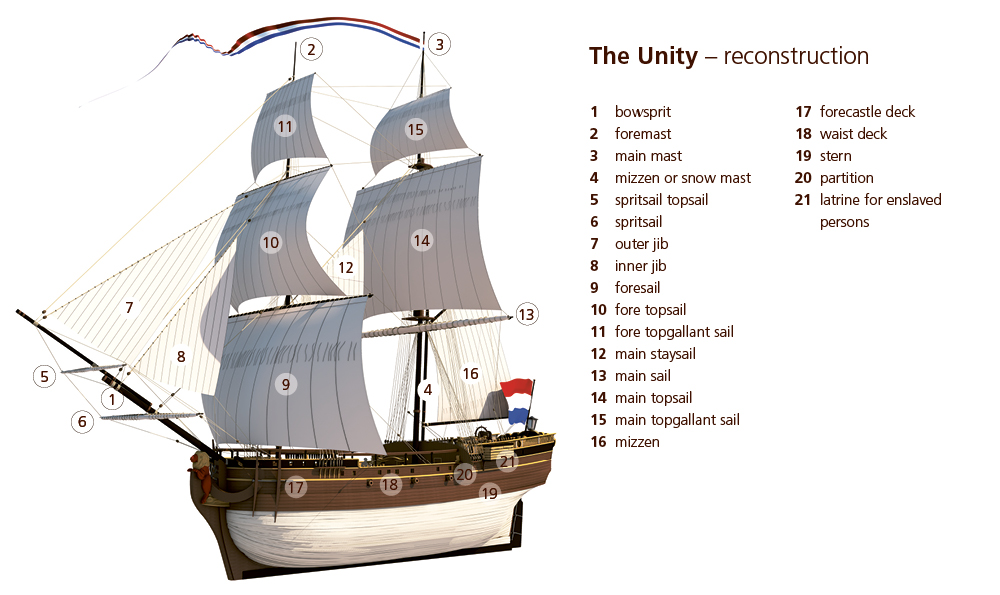In the logbook of The Unity first mate Daniël Pruijmelaar recorded extensive data about the ship’s navigation and position. A decisive factor was the wind.
Wind Force
On board of ships of the Republic the wind power was partly indicated by naming the maximum amount of sails that could be used at that moment. Nearly half of all the expressions related to wind power contain the name of a specific sail. Thanks to the descriptions given of which sails were used at a given moment, the wind force can be calculated and converted quite accurately to the currently used Beaufort scale.
Wind force on Beaufort scale – Actual experience at sea
Descriptions used in the logbook
Force 0 – Calm, glassy sea
Quiet, wind still
Force 1 – Ripples, no crests
Breeze, weak breeze, fresh breeze, light breeze, gentle breeze
Force 2 – Small wavelets with a glassy appearance, no breaking
Light royal sail breeze, breeze, gentle topgallant sail breeze, gentle breeze, weak breeze, average breeze
Force 3 – Large wavelets with some whitecaps and breaking crests
Topgallant sail breeze, light topgallant sail breeze
Force 4 – Small waves, breaking crests, more whitecaps.
Stiff topgallant sail breeze, fresh top sail breeze, top sail breeze
Force 5 – Moderate, longer waves with many whitecaps
Reefed top sail breeze, double reefed topgallant sail breeze, stiff top sail breeze
Force 6 – Long waves with frequent white foam crests and airborn spray.
Double reefed top sail breeze, stiff breeze, stiff reefed top sail breeze
Force 7 – Foam from waves creates streaks of white in the direction of the
Strong wind
Force 8 – Moderately high waves, crests beginning to break
Lower sail breeze
Force 9 – High waves, crests of the waves sometimes roll over, large amounts of airborne spray
Closely reefed top sail breeze, reefed lower sail breeze
Force 10 – Very high waves; sea looks white due to foam; lots of airborne spray
Closely reefed lower sail breeze, storm, heavy storm
Force 11 – Exceptionally high waves, sea covered in white foam streaks
(modern description: violent storm)
Force 12 – Huge waves, air filled with foam and airborne spray
(modern description: hurricane)
Other terms indicated in the logbook:
- To sail with furled sails. When a ship sails with completely furled sails the storm is so heavy that the risk of hoisting sails is too great. The wind force is at Force 10, 11, or 12 on the scale of Beaufort.
- Trade wind. A trade wind in this context is a heavy, short burst of wind with heavy rains. The word originates from the Portuguese word ‘travados’, which literally means ‘stormy winds on the coast of Guinea’ (Guinea being located on the West-African coast). A trade wind could be accompanied by thunder and lightning.
Sources:
- García-Herrera, R., e.a., CLIWOC Multilingual Meteorological Dictionary (2003), publicatie van het KNMI
- Rietveld, T., e.a., Handboek voor kustnavigatie. Eemdijk, 1999. (Dutch)
- Historical dictionaries by the Instituut voor de Nederlandse Taal. (Dutch)
…we put a reef in the sails…
When the wind increases in power, the surface area of the sails of a ship have to be reduced. Otherwise the power that the wind exerts on the ship will become too strong. The highest and smallest sails were the first to be taken in, followed by the lower and larger sails. From 1750 onwards, sails no longer had to be taken down in their entirety, but could be ‘reefed’ instead. A reef is a small portion of the sail that can folded in, making the sail smaller. The sails of The Unity could be taken in twice: double reefed. When, during severe weather, the two large sails were also taken in, the ship was sailing with completely furled sails.
Sails on board
The Unity was a square rigged ketch, which meant that the sails were hung from yards. On the main mast and the mizzen mast there were three superposed sails. The top sail was the topgallant sail, the middle the topsail. The bottom sail on the main mast was called the main sail or the mizzen sail and the bottom one on the foremast was called the foresail.
The Unity also had staysails, studding sails and spritsails. Staysails are triangular or trapezoidal shaped sails, named after the stays (spars) on which they were hoisted. On board of the Unity there were main topmast staysails (or jib staysails) and jibs.
Studding sails are small side sails that could be used on both sides of the square shaped sails.
A spritsail is a square sail that is hoisted on the spritsail yard below the bowsprit. Main spritsails and top spritsails were in use aboard the Unity.
Because of the detailed descriptions of the used sails a wind power from that time can be quite accurately converted to current wind powers measured on the scale of Beaufort.
Overview of the different sails on The Unity
Sails on board, ordered from bottom up; the number indicates how many there were on board. Source: ship’s inventory.
Square sails:
- Foremast: foresail fok (2), storm foresail (1), fore topsail (2), fore topgallant sail (2)
- Main mast: main sail (2), main top saill (2), main topgallant sail (2)
- Bowsprits: main spritsail (1), spritsail topsail (1)
- Upper studding sail (2) and lower studding sail (2)
Fore-and-aft sails
- Snow mast: mizzen (2)
Staysails
- Between the fore mast and bowsprits (2), Tussen voormast en boegspriet: binnenkluiver (2), large outer jib (2), jigger topmast staysail (1)
- Between the main mast and fore mast, bottom up: large staysail (14), main topmast staysail (1), topgallant mast staysail (1)


